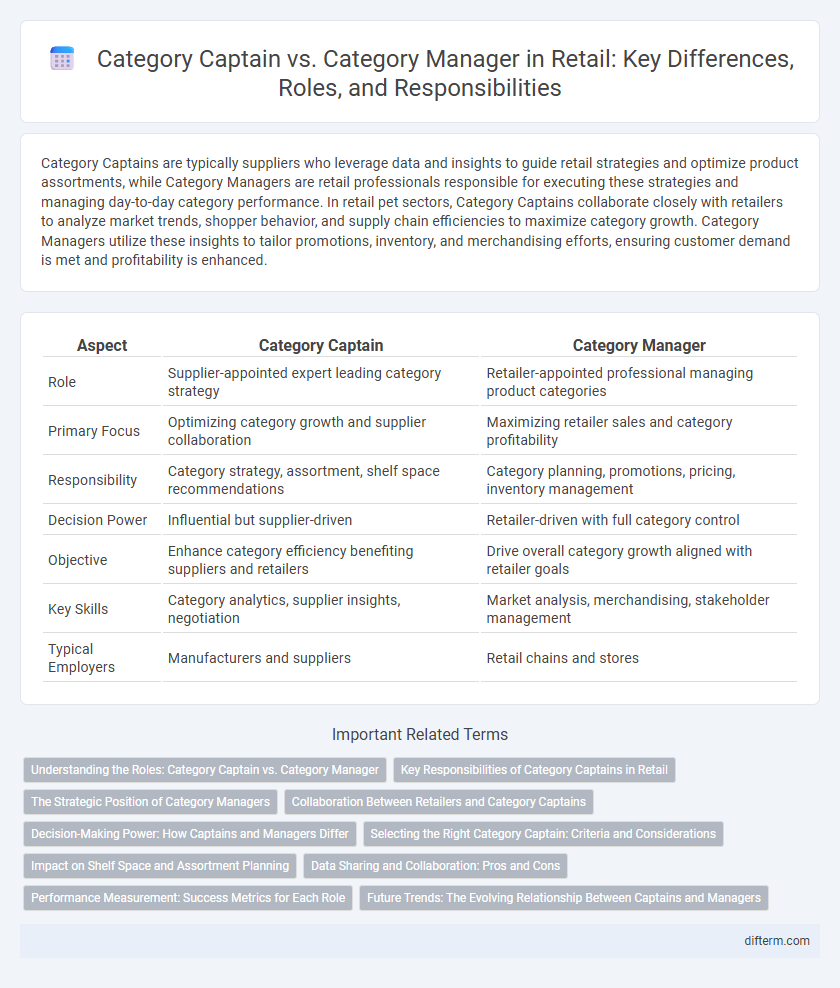Category Captains are typically suppliers who leverage data and insights to guide retail strategies and optimize product assortments, while Category Managers are retail professionals responsible for executing these strategies and managing day-to-day category performance. In retail pet sectors, Category Captains collaborate closely with retailers to analyze market trends, shopper behavior, and supply chain efficiencies to maximize category growth. Category Managers utilize these insights to tailor promotions, inventory, and merchandising efforts, ensuring customer demand is met and profitability is enhanced.
Table of Comparison
| Aspect | Category Captain | Category Manager |
|---|---|---|
| Role | Supplier-appointed expert leading category strategy | Retailer-appointed professional managing product categories |
| Primary Focus | Optimizing category growth and supplier collaboration | Maximizing retailer sales and category profitability |
| Responsibility | Category strategy, assortment, shelf space recommendations | Category planning, promotions, pricing, inventory management |
| Decision Power | Influential but supplier-driven | Retailer-driven with full category control |
| Objective | Enhance category efficiency benefiting suppliers and retailers | Drive overall category growth aligned with retailer goals |
| Key Skills | Category analytics, supplier insights, negotiation | Market analysis, merchandising, stakeholder management |
| Typical Employers | Manufacturers and suppliers | Retail chains and stores |
Understanding the Roles: Category Captain vs. Category Manager
Category Captains serve as strategic partners appointed by retailers to optimize category performance through data analytics, vendor collaboration, and shelf space management. Category Managers oversee the entire product category within a retailer, focusing on product selection, pricing, promotions, and inventory control to maximize profitability. While Category Captains provide vendor-driven insights and recommendations, Category Managers maintain decision-making authority and execute strategies to achieve retail goals.
Key Responsibilities of Category Captains in Retail
Category Captains in retail are responsible for driving category strategy by analyzing market data, consumer trends, and competitive dynamics to optimize product assortment and shelf space. They collaborate with suppliers and retailers to develop promotional plans, improve category profitability, and enhance shopper experience. Key duties include data-driven decision-making, performance tracking, and aligning category initiatives with overall business objectives.
The Strategic Position of Category Managers
Category Managers hold a strategic position by driving product assortment, pricing, and promotional strategies tailored to consumer demand and retail goals. Unlike Category Captains, who primarily provide supplier-driven insights, Category Managers integrate cross-functional data to optimize category performance and retailer profitability. Their role encompasses competitive analysis, inventory management, and collaboration with suppliers to align category strategy with overall business objectives.
Collaboration Between Retailers and Category Captains
Collaboration between retailers and category captains enhances category management by leveraging the captain's data analytics and supplier insights to optimize product assortment and shelf space. Category captains provide retailers with strategic recommendations based on sales trends and consumer behavior, facilitating targeted promotions and inventory decisions. This partnership drives improved category performance, increases shopper satisfaction, and boosts overall store profitability.
Decision-Making Power: How Captains and Managers Differ
Category Captains possess greater decision-making power by leveraging extensive market data and retailer insights to influence category strategies and shelf space allocation. Category Managers focus on implementing these strategies, optimizing product assortment, pricing, and promotional activities within retailer guidelines. The captain's strategic authority enables them to shape the overall category direction, while managers execute and refine tactics at the operational level.
Selecting the Right Category Captain: Criteria and Considerations
Selecting the right category captain involves evaluating expertise in market analytics, vendor relationship management, and strategic vision alignment with retail goals. Criteria include proven success in driving category growth, data-driven decision-making capabilities, and strong communication skills with both suppliers and internal teams. Considerations emphasize the captain's ability to lead category optimization, enhance shopper experience, and adapt quickly to market trends.
Impact on Shelf Space and Assortment Planning
Category Captains leverage data analytics and vendor insights to optimize shelf space allocation, driving increased sales and efficient product placement. Category Managers use retailer-specific strategies to balance assortment breadth with shopper preferences, ensuring category profitability and customer satisfaction. Both roles influence assortment planning, but Category Captains emphasize strategic collaboration with suppliers, while Category Managers focus on operational execution and merchandising.
Data Sharing and Collaboration: Pros and Cons
Category Captains facilitate centralized data sharing with retailers, enabling optimized shelf assortments and pricing strategies through detailed sales analytics, which enhances overall category performance but may reduce vendor autonomy and create dependency risks. Category Managers foster collaborative data exchange between manufacturers and retailers, promoting joint business planning and tailored marketing tactics, although inconsistent data formats and limited transparency can hinder effective cooperation. Effective data sharing requires balancing the benefits of insight-driven decisions with potential challenges such as data security and equitable access to information.
Performance Measurement: Success Metrics for Each Role
Category Captains measure performance through metrics such as category sales growth, market share improvement, and promotional effectiveness, emphasizing strategic insights and supplier collaboration. Category Managers focus on operational success metrics including inventory turnover, shelf profitability, and in-store execution accuracy to optimize day-to-day category performance. Both roles drive retail success by complementing strategic planning with tactical management aligned to key performance indicators.
Future Trends: The Evolving Relationship Between Captains and Managers
Category captains leverage advanced analytics and AI to provide deeper consumer insights, reshaping collaboration with category managers who increasingly focus on strategic innovation and personalized customer experiences. Emerging trends highlight greater integration of digital tools and data-driven decision-making to optimize assortment planning, inventory management, and promotional strategies across retail channels. The future relationship between category captains and managers centers on synergistic partnerships that drive agility, predictive analytics, and omnichannel growth for sustained competitive advantage.
Category Captain vs Category Manager Infographic

 difterm.com
difterm.com